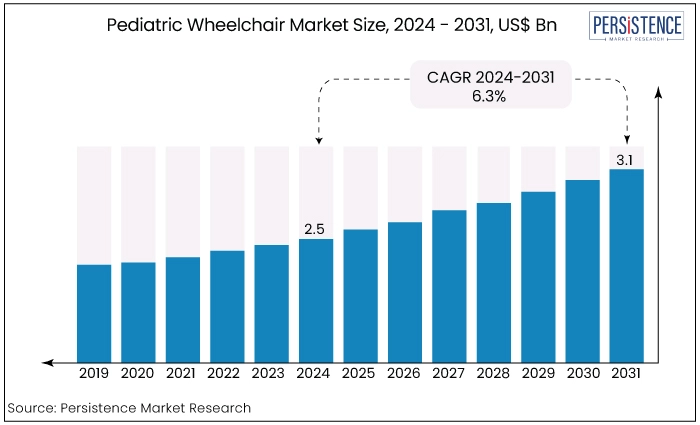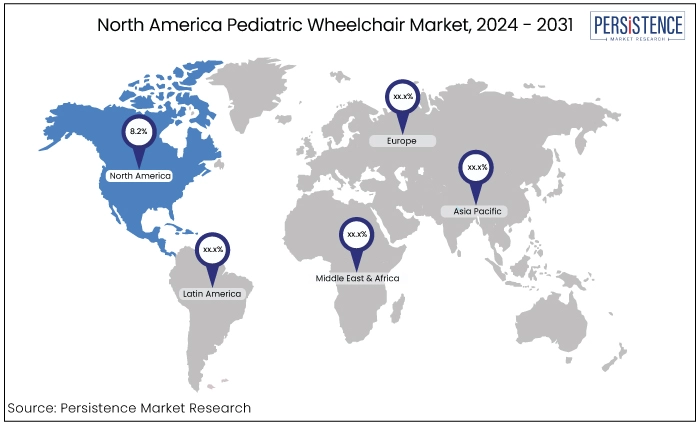Industry: Healthcare
Published Date: September-2024
Format: PPT*, PDF, EXCEL
Delivery Timelines: Contact Sales
Number of Pages: 171
Report ID: PMRREP34760
The global market is estimated to be valued at US$3.1 Bn by 2031 up from US$2.5 Bn recorded in 2024. The market is projected to secure a CAGR of 6.3% during the forecast period between 2024 and 2031. The market growth is driven by advancements in wheelchair technology, growing demand for customization and increasing rate of pediatric disabilities. Significant innovation fueled by the demand for advanced wheelchair designs and materials enhance the user experience for pediatric wheelchairs.

Key Highlights of the Market
|
Market Attributes |
Key Insights |
|
Pediatric Wheelchair Market Size (2024E) |
US$2.5 Bn |
|
Projected Market Value (2031F) |
US$3.1 Bn |
|
Global Market Growth Rate (CAGR 2024 to 2031) |
6.3% |
|
Historical Market Growth Rate (CAGR 2019 to 2023) |
5.2% |
|
Region |
CAGR through 2031 |
|
North America |
8.2% |
North America is poised to account for a significant share of the pediatric wheelchair market due to a combination of factors that collectively bolster its market position. The advanced healthcare infrastructure in North America plays a crucial role.
The region boasts some of the most sophisticated healthcare facilities and technologies globally. This infrastructure supports the adoption of advanced and specialized pediatric wheelchairs, including those with cutting-edge features such as smart technologies, and customizable designs.
The strong presence of well-established healthcare systems ensures that families and healthcare providers have access to the latest innovations and high-quality products.

|
Region |
CAGR through 2031 |
|
Asia Pacific |
9.0% |
Asia Pacific is poised to exhibit a notable CAGR of 9.0% in the market due to a combination of demographic, economic, and healthcare factors. The region's burgeoning population, particularly its growing number of children with special needs creates a substantial demand for pediatric wheelchairs.
As economies in countries like China, India, and Southeast Asian nations continue to develop, there is an increased focus on improving healthcare infrastructure and access to medical equipment, including specialized wheelchairs.
Economic growth in Asia Pacific has led to high disposable incomes and expanding middle-class populations, which enhances the ability of families and healthcare systems to invest in advanced and customized pediatric wheelchairs.
Government initiatives and healthcare policies aimed at supporting people with disabilities are improving access to necessary medical equipment and services. This policy shift is supported by rising awareness about disability rights and the importance of mobility aids in enhancing the quality of life for children with physical disabilities.
|
Category |
Projected CAGR through 2031 |
|
Type - Manual Wheelchair |
6.9% |
The manual wheelchair segment is projected to account for a significant share of the pediatric wheelchair market due to several compelling factors that underline its enduring popularity and practical advantages. Manual wheelchairs offer a cost-effective solution compared to their powered counterparts making them a more accessible option for many families and healthcare systems.
The affordability of manual wheelchairs aligns with budget constraints often faced by parents and medical providers, especially in regions with limited resources. Another key factor is the simplicity and reliability of manual wheelchairs. These devices require less maintenance and are less prone to technical issues compared to powered models. Their mechanical design eliminates concerns about battery life and electrical malfunctions, offering a dependable option for everyday use.
Manual wheelchairs provide a level of physical activity that can be beneficial for children. Pushing a manual wheelchair encourages upper body strength and can contribute to physical therapy goals, which is particularly advantageous in pediatric care.
|
Category |
Projected CAGR through 2031 |
|
Distribution Channel - Direct Sales |
6.5% |
The direct sales distribution channel holds a significant share in the pediatric wheelchair market. It is due to several compelling factors including catering to both the specific needs of the consumers and the unique characteristics of the products.
Personalized service is a critical advantage of direct sales. Pediatric wheelchairs often require customization to meet the specific needs of individual children such as adjustments for growth, medical conditions, and personal preferences.
Direct sales channels allow for better control over product quality and support. Manufacturers and specialized dealers can ensure that the wheelchairs meet high standards of quality and safety.
The market encompasses a range of mobility devices designed specifically for children with physical disabilities or mobility impairments. These wheelchairs cater to various needs, from basic mobility to advanced therapeutic support, ensuring that children can lead active and fulfilling lives.
The market is mainly driven by the rising prevalence of disabilities and mobility impairments among children, which increases the demand for specialized wheelchairs. Technological advancements in wheelchair design such as improved materials, ergonomic features, and power-assist technology further boost market growth by offering enhanced comfort and functionality.
Growing awareness and advocacy for accessible mobility solutions coupled with increased government and healthcare funding support the acquisition of these specialized devices. The market is also influenced by a trend toward personalized and customizable wheelchairs, which cater to individual needs and preferences. Consequently, improving the quality of life for children with disabilities.
Customization helps address specific medical needs such as postural support or pressure relief by incorporating specialized components like contoured cushions or adjustable headrests. This ensures that the wheelchair supports the user's health and well-being while also accommodating their lifestyle and activities.
The pediatric wheelchair market has experienced significant growth in recent years driven by rising awareness of pediatric mobility needs and advances in wheelchair technology. The market has seen steady expansion due to increasing prevalence of pediatric disabilities and a growing emphasis on improving the quality of life for children with mobility challenges.
Enhanced healthcare infrastructure and advancements in wheelchair design have contributed to the market's expansion with notable growth in the adoption of both manual and powered wheelchairs.
The market is projected to continue its upward trajectory. Forecasts indicate robust growth, supported by several factors. The growing focus on personalized medicine and child-specific needs in mobility solutions is likely to bolster market growth.
Emerging markets particularly in Asia Pacific present significant opportunities due to improving healthcare access and rising awareness. Additionally, the integration of innovative features such as enhanced adjustability and improved materials will further boost the demand for advanced pediatric wheelchairs.
Rising Awareness of Pediatric Disabilities
The rising awareness of pediatric disabilities plays a pivotal role in driving the demand for specialized wheelchairs tailored to the unique needs of children facing mobility challenges. Over recent years, there has been a significant increase in public and medical community awareness about various pediatric disabilities such as cerebral palsy, muscular dystrophy, and spinal cord injuries.
Rising awareness of pediatric disabilities drives the market by increasing demand for specialized mobility solutions and advocating for improved accessibility. As awareness grows, more families and healthcare providers recognize the critical need for tailored wheelchairs that cater to the unique needs of children with disabilities.
Heightened understanding leads to greater advocacy and support for better-designed, more functional wheelchairs. Additionally, increased awareness prompts more funding and resources from both public and private sectors, enhancing the availability and development of innovative wheelchair solutions
Increasing Prevalence of Pediatric Disabilities
The increasing prevalence of pediatric disabilities is significantly influencing the demand for specialized mobility solutions including wheelchairs designed to meet the unique needs of affected children. Conditions such as cerebral palsy, muscular dystrophy, and spinal cord injuries are becoming increasingly recognized due to advances in medical diagnostics and improved reporting.
Conditions often present significant challenges in terms of mobility and daily functioning, Cerebral palsy, for instance, affect muscle coordination and movement leading to a high demand for wheelchairs that offer both postural support and manoeuvrability.
Muscular dystrophy leads to progressive muscle weakness requiring wheelchairs that can be adjusted to accommodate changing physical conditions and provide comfort during extended use. Spinal cord injuries, often resulting from trauma or congenital issues, demand highly customizable wheelchairs to support proper alignment and prevent complications such as pressure sores.
High Cost of Advanced Models
The high cost of advanced and customizable pediatric wheelchairs represents a substantial barrier to accessibility particularly in regions with limited healthcare funding. This factor remains a key factor restraining the pediatric wheelchair market.
Pediatric wheelchairs equipped with cutting-edge technology, such as sophisticated power-assist features, specialized seating systems designed to meet the specific needs of young users. This high cost can be prohibitive for many families and healthcare systems.
The financial burden is compounded by the fact that insurance coverage for these advanced models can be inconsistent leaving families to bear a significant portion of the expense out-of-pocket. This economic challenge can lead to delays in obtaining necessary mobility aids, potentially affecting the quality of life and developmental opportunities for children with disabilities.
Increased investment in affordable solutions and subsidies that can help bridge the cost gap is needed to mitigate this issue. Additionally, efforts to streamline regulatory processes and encourage insurance companies to offer better coverage for high-end pediatric wheelchairs could alleviate some of the financial pressures.
Durability and Maintenance Concerns
Durability and maintenance concerns play a crucial role in the long-term adoption and effective use of pediatric wheelchairs, impacting both user satisfaction and healthcare costs. Pediatric wheelchairs especially those designed for active children are subjected to significant wear and tear making durability a critical factor.
High-quality materials and robust construction are essential to withstand daily use and varying environmental conditions. However, advanced models with intricate designs and high-tech components may face challenges in maintaining their structural integrity over time potentially leading to increased repair needs or premature replacements.
The complexity of some modern wheelchairs can complicate maintenance procedures. Specialized components and advanced features often require regular upkeep by skilled technicians, which may not be readily available in all regions.
Families and caregivers might find it challenging to perform routine maintenance or repairs, particularly if they lack the technical expertise or access to professional support. This can result in extended periods without proper mobility aids, affecting the child’s overall quality of life and hindering their ability to engage in daily activities.
Integration with Smart Technologies
Integration with smart technologies in pediatric wheelchairs presents a transformative opportunity to enhance mobility and health management for children with physical disabilities. By incorporating the Internet of Things (IoT) and smart technology, these wheelchairs can evolve beyond traditional mobility aids to become sophisticated health management tools. For instance,
Smart technologies can facilitate a personalized user experience. Advanced control systems can adapt to a child’s specific physical abilities and preferences making it easy to operate and maneuver the wheelchair. Features such as voice controls or adaptive interfaces can further enhance usability, accommodating children with varying levels of motor function.
Collaborations and partnerships to develop innovative products and accelerate their launch across nations are the key growth strategies followed by the key players in the market. Companies are continuously investing in research and development to introduce innovative and novel interference blockers.
Strategic partnerships with healthcare providers, rehabilitation centers, and research institutions are common. These collaborations can lead to the development of advanced products and expand market reach.
The market includes companies that are leveraging advanced technologies, such as smart wheelchairs with integrated sensors and connectivity features. These innovators are often smaller or emerging companies that focus on integrating cutting-edge technology into mobility solutions.
Recent Developments in the Pediatric Wheelchair Market
|
Attributes |
Details |
|
Forecast Period |
2024 to 2031 |
|
Historical Data Available for |
2019 to 2023 |
|
Market Analysis |
US$ Billion for Value |
|
Key Regions Covered |
|
|
Key Market Segments Covered |
|
|
Key Companies Profiled in the Report |
|
|
Report Coverage |
|
|
Customization & Pricing |
Available upon request |
By Type
By Mobility
By Distribution Channel
By Region
To know more about delivery timeline for this report Contact Sales

Increased awareness and better diagnostic practices have led to a high identification of physical disabilities in children boosting the need for specialized mobility aids.
Some of the key players operating in the market are MEYRA GmbH, Sunrise Medical, and SORG.
The manual wheelchair to record a significant share in the market.
A key opportunity lies in the introduction of advanced wheelchairs with integrated smart technology enabling real-time health monitoring.
North America is set to account for significant share in the market.